

Another week has passed and it is time to review the best of what hit our blog in the past week.
In first place is a repeat from last week showing how you can turn an Android device with a CMOS camera into a radiation detector.
In first place if we ignore repeats is a post about how the Raspberry Pi board can decode 1080p video! We’re just itching to get our grubbly little hands on some of these guys when they are finally released.
Up next is a project from one of our own. This week [Brian Benchoff] put up a post about how he built a manifold clock after seeing a similar project on Kickstarter.
Following that is a post showing how you can overlay video onto an encrypted HDMI signal. The MPAA would probably like to crack [bunnie] over the knuckles with a ruler for this one but he actually isn’t decrypting anything. Instead, he is encrypting the overlay and just replacing the normal video with it.
We like this next one a lot because it not only is a nice hack but it allows you to subtly control what can and cannot happen around you. Specifically, you can jam remote control helicopters with this device. It probably wouldn’t be too hard to pair this up with a TV B Gone to keep people from turning the TV back on once you have wrought your mischief.
Finally, another really neat one for you. In this post, we show [Sprite_tm’s] radio transmitter that is composed out of two button cell batteries, two lengths of wire and an ATtiny processor. It is amazing that this even works but with the right tools, a good hacker can do just about anything.

















